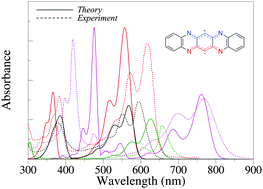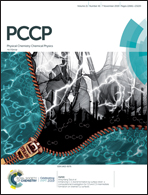First principles investigation of the spectral properties of neutral, zwitterionic, and bis-cationic azaacenes†
Abstract
An in-depth investigation of the optical properties of recently-synthesized linear azaacene derivatives of various electronic nature (neutral, dicationic, and zwitterionic) is presented. Our simulations include not only the determination of the vertical transitions, but also of the adiabatic energies and vibrationally-resolved spectra using the adiabatic Hessian approach in connection with the Time-Dependent Density Functional Theory (TD-DFT) and second-order Coupled-Cluster (CC2) methods. We show that the theoretical results are in excellent agreement with experiment for both the λmax and the band topologies, a statement holding in the full visible domain. We also analyse the nature of the key vibrations explaining the specific band shapes of these compounds. In addition, we investigate a series of yet-unknown substituted systems in an effort to design new compounds with improved (redshifted) properties for optoelectronics applications.



 Please wait while we load your content...
Please wait while we load your content...